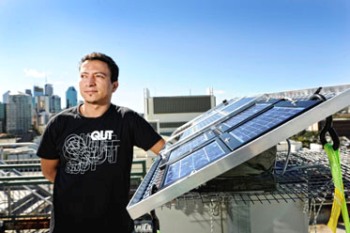Alexander Malaver, a Masters student at the Queensland University of Technology (QUT), has designed a solar-powered nano sensor that is capable of tracing gases that cause air pollution and climatic changes. This sensor has been installed on the roof of QUT Gardens point and is part of the solar-powered environmental nano sensor study being conducted worldwide.
 Alexander Malaver with the Solar Nano Sensor
Alexander Malaver with the Solar Nano Sensor
Malaver explained that the sensor prototype is part of a network of solar-powered sensors that would monitor the environmental concentration of the three major air pollutants which include nitrogen dioxide, nitrous oxide and ammonia. He added that conventional pollution monitoring systems were not capable of detecting these gases as they are present in very small quantities in the atmosphere. He explained that nitrous oxide and ammonia are worse air pollutants when compared to carbon dioxide. The research is targeted at making people aware in real time about the presence of these gases in the atmosphere so they can adapt accordingly.
Malaver stated that the sensor network will be wirelessly connected in such a way that each node would be able to communicate with the other and transmit the measured data in real time to a central monitoring system from which the data would be available for viewing on any computer within the QUT network.
Malaver explained that the sensors comprised metal oxide nanowires and carbon nanotubes and derive power from dye-sensitized solar cells which capture solar energy just like plants.